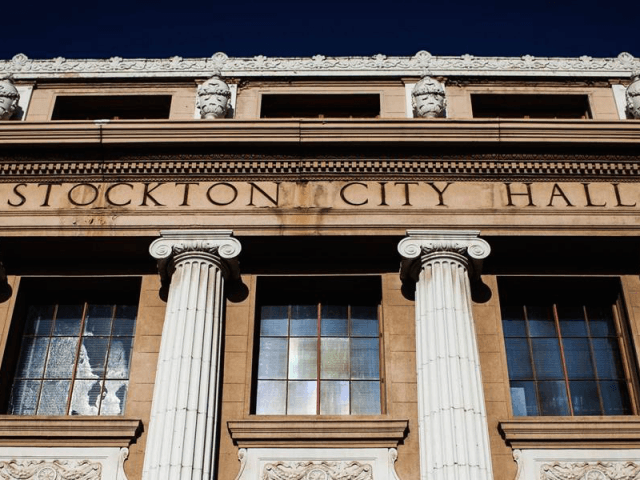The City of Stockton emerged from bankruptcy on Wednesday, February 25, after a 31-month ordeal. There were no winners in trying to restructure over $2 billion in debt and obligations.
Nearly half of non-safety city employees were dumped, the survivors’ wages were cut by up to 23 percent, and retirees lost $500 million in lifetime medical benefits. Bondholders and creditors are receiving pennies on the dollar. Hopefully the sad lessons about what happened to Stockton might help other California cities to control spending.
The City of Stockton had been ground zero in California’s real estate boom with a population spiking from 240,000 in 2000 to 290,000 in 2007. Flush with rising property and sales tax cash flow, the city government went on a hiring and building spree. Unions negotiated big employee raises and city-paid lifetime healthcare benefits.
As part of a “City Beautiful” initiative, the old city hall went through an expensive “Renaissance Revival” that included refurbishment of the carved stone city motto over the entrance that says: “To inspire a nobler civic life; to fulfill justice; to serve the people.”
To finance the renaissance expansion, the City issued $320 million in general fund debt between 2003 and 2009. To postpone burgeoning pension and health-care costs, Stockton simply borrowed another $125 million in debt in 2007 to double up investments in the hot stock market.
But in the Great Recession the combination of the bottom falling out of the real estate market and that hot stock market tanking devastated the Stockton finances. Housing values plummeted by 70 percent, crushing revenues. A back-loaded interest payment schedule caused interest and principal payments on debt to balloon by 600 percent.
After reneging on the promised retiree medical plan, the Stockton reorganization plan supposedly continues to pay the California Public Employee’s Retirement System pension costs in full, but the City did achieve a ruling that it could still file for bankruptcy again and potentially dump most of the pension liabilities.
Although the Stockton ran up bankruptcy costs of about $41 million, my estimate is that the City reduced debt and other obligations by about $750 million. City Manager Kurt Wilson told Sacramento-area FOX40 News that being out of bankruptcy does not mean the city is completely out of debt. City officials will have to tighten up the purse strings when spending cash for the next few decades. “Being out of bankruptcy means we’re stable, so the path that we’re on right now, the current trajectory, we can sustain.”
Stockton no longer is a town with grandiose expectations. The goal of Stockton’s new Mayor Silva is to maintain the stability by keeping spending down and using sales-tax-increase revenue to fund 120 new police officers in the next few years.
City officials have penned an open letter to the community to explain humbly what happened in the past and how they hope to better manage the City of Stockton in the future now that they have emerged from bankruptcy. Click here to read the letter.

COMMENTS
Please let us know if you're having issues with commenting.